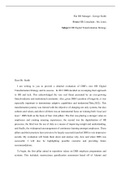To: HR Manager - George Smith
From: HR Consultant - Ms. Jones
Subject: HR Digital Transformation Strategy
Dear Mr. Smith
I am writing to you to provide a detailed evaluation of DBS’s new HR Digital
Transformation Strategy and its success. In 2012 DBS decided on revamping their approach
to HR and tech. This acknowledged the very real threat presented by an ever-growing
fintech-industry and institutional constraints. Also, given DBS’s position of longevity, it was
especially important to demonstrate adaptive capabilities and modernise(Thite,2022). This
transformation journey was formed with the objective of changing not only systems, but also
cultures and values, and above all there was an instrumental focus on winning both ‘head and
heart’. DBS built on the basis of four vital pillars: The first was placing a stronger value on
employees and creating amazing experiences, the second was the digitalisation of HR
processes, the third was the use of data as a means of improving insight and understanding,
and finally, the widespread encouragement of continuous learning amongst employees. These
pillars and their practices have proven to be largely successful and led DBS to win impressive
awards. My evaluation will break them down and analyse why, how and where DBS was
successful. I will also be highlighting possible concerns and providing future
recommendations.
To begin, the first pillar aimed to reposition values on DBS employee programmes and
systems. This included, neuroscience gamification assessment based off of Alumni and
, current employee scores, the introduction of J.I.M. the AI-recruiter, and a redesign of the
onboarding process. There are clear advantages to these measures, for example by testing
candidate cognitive behaviours with gamification the organisation is now able to select
employees who will be a better cultural fit, saving time and recruitment costs. Furthermore,
the faster,real-time,24/7-recruiter companion,J.I.M., reduced the drop-off rate from 15% to
3%, the general screening time by 75%, and saved 25% of recruiter time. Lastly, the
onboarding microsite allowed for easy access information and resources, reducing labour
input and improving new candidate assimilation/experiences. However, there is a risk that
JIM is biased and detrimental to the business. In 2018 Amazon’s AI was proven to have a
bias against female applicants(Windley, 2021). Thus, DBS should be careful and vigilantly
monitor fairness and diversity of all AI picked candidates. This recommendation may seem
costly, but DBS could fund it using the savings they made in earlier reduced staff costs.
The second pillar continues to focus on transformation. Here, the new practices were an
enhancement of technology infrastructure and new HR systems to enable self-service and
online processing of online transactions, a new Human Capital Management(HCM) system
on cloud, the automation of administrative and manual services, and an AI HiRi-Chatbot.
These meant employees could manage over 20 services, and managers could manage self-
services while assisted by data. The HCM system went on to provide a one-stop portal for
HR matters, such as letters and performance management, making managers increasingly
effective. The elimination of admin and manual services also made processing 90% more
efficient and reduced handling time by 87%. Still, a common danger with automated bots and
processes is that employees may feel unsatisfied or un-heard. To prevent this DBS should be
ensuring that these are accompanied by actual human interaction, HR should consider
upskilling now redundant employees as companions. On that note, it is important for HR to
ensure that employees who have been replaced have alternative job opportunities or are able
to adapt to other paths them with learning and development programmes. Exactly like they
did with Bee Lay Png. My recommendations here will also help counteract any future issues
that could arise from labour unionisation or employee dissatisfaction.
The third pillar focuses on how DBS utilises data to gather insight, make predictions and
prescribe change. Here a new Human-Capital-Analytics(HCA) Team focused on recruitment,
retention and productivity. They were able to use data analytics to assist both the organisation
in terms of productivity and the employees in terms of decision making. However, DBS




